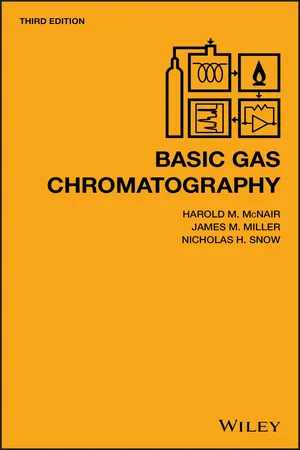
- English
- ePUB (mobile friendly)
- Available on iOS & Android
Basic Gas Chromatography
About this book
Basic Gas Chromatography, Third Edition provides a brief introduction to GC following the objectives for titles in this series. It should appeal to readers with varying levels of education and emphasizes a practical, applied approach to the subject.: This book provides a quick need-to-know introduction to gas chromatography; still the most widely used instrumental analysis technique, and is intended to assist new users in gaining understanding quickly and as a quick reference for experienced users.
The new edition provides updated chapters that reflect changes in technology and methodology, especially sample preparation, detectors and multidimensional chromatography. The book also covers new detectors recently introduced and sample preparation methods that have become much more easily accessible since the previous edition.
Frequently asked questions
- Essential is ideal for learners and professionals who enjoy exploring a wide range of subjects. Access the Essential Library with 800,000+ trusted titles and best-sellers across business, personal growth, and the humanities. Includes unlimited reading time and Standard Read Aloud voice.
- Complete: Perfect for advanced learners and researchers needing full, unrestricted access. Unlock 1.4M+ books across hundreds of subjects, including academic and specialized titles. The Complete Plan also includes advanced features like Premium Read Aloud and Research Assistant.
Please note we cannot support devices running on iOS 13 and Android 7 or earlier. Learn more about using the app.
Information
1
INTRODUCTION

A BRIEF HISTORY
DEFINITIONS
Chromatography
Chromatography is a physical method of separation in which the components to be separated are distributed between two phases, one of which is stationary (stationary phase) while the other (the mobile phase) moves in a definite direction. Elution chromatography is a procedure in which the mobile phase is continuously passed through or along the chromatographic bed and the sample is fed into the system as a finite slug [9].
Table of contents
- COVER
- TABLE OF CONTENTS
- PREFACE TO THE THIRD EDITION
- PREFACE TO THE SECOND EDITION
- PREFACE TO THE FIRST EDITION
- ACKNOWLEDGMENTS
- 1 INTRODUCTION
- 2 BASIC CONCEPTS AND TERMS
- 3 INSTRUMENT OVERVIEW
- 4 CAPILLARY COLUMNS
- 5 STATIONARY PHASES
- 6 TEMPERATURE PROGRAMMING
- 7 INLETS
- 8 CLASSICAL DETECTORS: FID, TCD, AND ECD
- 9 QUALITATIVE AND QUANTITATIVE ANALYSIS
- 10 GC‐MS AND SPECTROMETRIC DETECTORS
- 11 SAMPLING METHODS
- 12 MULTIDIMENSIONAL GAS CHROMATOGRAPHY
- 13 PACKED COLUMN GC
- 14 SPECIAL TOPICS
- 15 TROUBLESHOOTING GC SYSTEMS
- APPENDIX A: ACRONYMS, SYMBOLS AND GREEK SYMBOLS
- APPENDIX B: SOME INTERNET SITES FOR GAS CHROMATOGRAPHY
- APPENDIX C: OTHER BOOKS ON GAS CHROMATOGRAPHY
- INDEX
- END USER LICENSE AGREEMENT